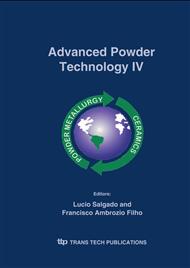p.630
p.636
p.642
p.648
p.654
p.658
p.663
p.669
p.676
Obtaining of the Ceramics Pigments (Fe, Zn)Cr2O4 Using Waste of Electroplating as Raw Material
Abstract:
The solid material from electroplating wastewater treatment was used as raw material in synthesis of ceramic pigments, once the formation of ZnCr2O4 and FeCr2O4 crystalline phases can be considered as a process of heavy metals inertization, such as chromium, zinc and iron. To reach the purpose of this paper, the techniques of elementary chemical analysis (Atomic Absorption Spectroscopy and X-Ray Fluorescence, thermal analysis (DTA/TGA) and X-Ray Diffraction were applied in samples of waste with the aim of physical and chemical characterization. After the characterization of residue were incorporate metallic oxides for correction of composition and obtaining of inorganic pigment. Pigment formation was followed through X-ray diffraction, where the formation of spinel phases containing the metals Fe, Cr and Zn were observed. The pigment was characterized through scanning electron microscopy, differential thermal analysis and thermogravimetry. The 8 hours cycle calcinated pigments formed crystalline spinel phases, where we can say that the present metals in the sludge became inert. It was possible to incorporate up to 20% of the galvanic waste in the production of Fe, Cr and Zn based inorganic pigments.
Info:
Periodical:
Pages:
654-657
Citation:
Online since:
November 2005
Authors:
Keywords:
Price:
Сopyright:
© 2005 Trans Tech Publications Ltd. All Rights Reserved
Share:
Citation:


